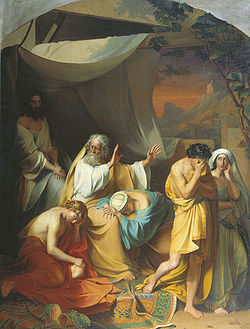
Back لعنة حام Arabic Maledicció de Cam Catalan Maldición de Cam Spanish نفرین حام Persian Malédiction de Canaan French שכרות נח HE Kutukan Ham ID 함의 저주 Korean Przekleństwo Chama Polish Maldição de Cam Portuguese

In the Book of Genesis, the curse of Ham is described as a curse which was imposed upon Ham's son Canaan by the patriarch Noah. It occurs in the context of Noah's drunkenness and it is provoked by a shameful act that was perpetrated by Noah's son Ham, who "saw the nakedness of his father".[1][2] The exact nature of Ham's transgression and the reason Noah cursed Canaan when Ham had sinned have been debated for over 2,000 years.[3]
The story's original purpose may have been to justify the biblical subjection of the Canaanites to the Israelites,[4] or a land claim to a portion of New Kingdom of Egypt which ruled Canaan in the late Bronze Age.[5][6]
In later centuries, the narrative was interpreted by some Jews, Christians and Muslims as an explanation for black skin, as well as a justification for enslavement of black people.[7][8]
Nevertheless, most Christians, Muslims and Jews now disagree with such interpretations, because in the biblical text, Ham himself is not cursed, and neither race nor skin color are ever mentioned.[9][disputed ]
- ^ Sarna 1981, p. 76.
- ^ Genesis 9:22
- ^ Goldenberg 2003, p. 157.
- ^ Alter 2008, pp. 52–53.
- ^ Mathee, Mohamed Shahid (1 Dec 2016). "Curse motives in the "Curse of Ham" narrative : land for Yahweh's landless people?". Journal for Semitics. 25 (2): 726–747. doi:10.25159/1013-8471/2554. ISSN 2663-6573.
- ^ Redford, Donald B. (1992). Egypt, Canaan, and Israel in Ancient Times. Princeton University Press. ISBN 978-0-691-21465-8.
- ^ Goldenberg 2003, p. 170.
- ^ Gomez 2018, p. 47–50.
- ^ Whitford 2009, p. 35; Ham, Sarfati & Wieland 2001.
© MMXXIII Rich X Search. We shall prevail. All rights reserved. Rich X Search